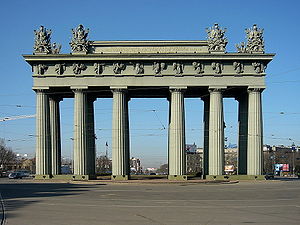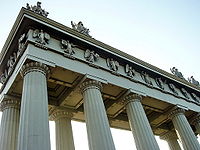
Moscow Triumphal Gates
Encyclopedia

Neoclassical architecture
Neoclassical architecture was an architectural style produced by the neoclassical movement that began in the mid-18th century, manifested both in its details as a reaction against the Rococo style of naturalistic ornament, and in its architectural formulas as an outgrowth of some classicizing...
triumphal arch
Triumphal arch
A triumphal arch is a monumental structure in the shape of an archway with one or more arched passageways, often designed to span a road. In its simplest form a triumphal arch consists of two massive piers connected by an arch, crowned with a flat entablature or attic on which a statue might be...
in Saint Petersburg
Saint Petersburg
Saint Petersburg is a city and a federal subject of Russia located on the Neva River at the head of the Gulf of Finland on the Baltic Sea...
, Russia
Russia
Russia or , officially known as both Russia and the Russian Federation , is a country in northern Eurasia. It is a federal semi-presidential republic, comprising 83 federal subjects...
. The monument — built mainly in cast iron
Cast iron
Cast iron is derived from pig iron, and while it usually refers to gray iron, it also identifies a large group of ferrous alloys which solidify with a eutectic. The color of a fractured surface can be used to identify an alloy. White cast iron is named after its white surface when fractured, due...
— was erected in 1834 -1838 in the memory of the Russian victory in the Russo-Turkish War, 1828-1829
Russo-Turkish War, 1828-1829
The Russo–Turkish War of 1828–1829 was sparked by the Greek War of Independence. The war broke out after the Sultan, incensed by the Russian participation in the Battle of Navarino, closed the Dardanelles for Russian ships and revoked the Akkerman Convention....
.
19th century
At the beginning, the triumphal gate was supposed to be erected by the Obvodny CanalObvodny Canal
Obvodny Canal is the longest canal in Saint Petersburg, Russia, which in the 19th century served as the southern limit of the city. It is 8 km long and flows from the Neva River near Alexander Nevsky Lavra to the Yekaterinhofka not far from the sea port. The canal was dug in 1769-1780 and 1805-1833...
, but as the city expanded further to the south, the site for the gate was moved to the intersection of the Moscow highway (today: the Moscow Avenue
Moskovsky Prospekt
Moskovsky Prospekt is a 10 km-long prospekt in Saint Petersburg, Russia. It runs from Sennaya Square and Sadovaya Street, to the Victory Square, where it splits into Pulkovo Highway and Moscow Highway. It crosses Fontanka River, Zagorodny Prospekt, Obvodny Canal, and Ligovsky Prospekt...
) and the Ligovsky Canal
Ligovsky Canal
Ligovsky channel is one of the most extended channels of Saint Petersburg .It has been constructed in 1721, its length has made 23 kilometres.The channel was under construction for functioning of fountains of Summer garden....
. In addition, two guard posts were erected on both sides of the Moscow highway. In this way, the monument not only became a triumphal structure, but also a gateway into the imperial capital.
The Moscow Triumphal Gate were designed by the Russian architect Vasily Stasov
Vasily Stasov
Vasily Petrovich Stasov was a Russian architect.-Biography:Stasov was born in Moscow....
, who was also responsible for the Narva Triumphal Gate
Narva Triumphal Gate
The Narva Triumphal Arch was erected in the vast Narva Square , Saint Petersburg, in 1814 to commemorate the Russian victory over Napoleon. The wooden structure was constructed on the Narva highway with the purpose of greeting the soldiers who were returning from abroad after their victory over...
at the other entrance to the city. Stasov, an exponent of the Empire style, originally developed two different designs for the gate before a full size model of one of the designs was erected. The project was confirmed on September 14, 1834. In the following year, the Neoclassical sculptor Boris Orlovsky
Boris Orlovsky
Boris Ivanovich Orlovsky , , was a Russian sculptor.Born into a peasant family in Tula, Russia, his artistic talent led to him being freed by his master and sent to the Imperial Academy of Arts in Saint Petersburg. After studying in Italy under Bertel Thorvaldsen, he returned to teach at the...
developed models of the sculpture details of the gate, including war trophies
Trophy
A trophy is a reward for a specific achievement, and serves as recognition or evidence of merit. Trophies are most often awarded for sporting events, from youth sports to professional level athletics...
and figures of genius
Genius
Genius is something or someone embodying exceptional intellectual ability, creativity, or originality, typically to a degree that is associated with the achievement of unprecedented insight....
es.
The chief material to be used in building the gate was cast iron. The castings for the ends of the columns and walls located above the cornice
Cornice
Cornice molding is generally any horizontal decorative molding that crowns any building or furniture element: the cornice over a door or window, for instance, or the cornice around the edge of a pedestal. A simple cornice may be formed just with a crown molding.The function of the projecting...
s, the forging from the sheets of copper sculpture details including the figures of geniuses, trophies and upper parts of the columns were produced at a local factory. The cast iron for the columns were cast in another local factory.

The monumental portico made of the powerful columns symbolized greatness and glory of the Russian army. The war victory theme was further underlined with the sculpture compositions of war trophies, signs and weapons. The use of a frieze
Frieze
thumb|267px|Frieze of the [[Tower of the Winds]], AthensIn architecture the frieze is the wide central section part of an entablature and may be plain in the Ionic or Doric order, or decorated with bas-reliefs. Even when neither columns nor pilasters are expressed, on an astylar wall it lies upon...
of 30 sculptural figures of genius made from copper sheets of seven different models in the monument was considered an architectural innovation of the day.
Being erected as a memorial of a military victory, the main concept behind the gate was the ostentatious display of state power. This concept is inherent in most of Stasov's designs in Saint Petersburg, such as the Pauline Barracks (1817-1821), the Trinity Cathedral
Trinity Cathedral, St. Petersburg
The Trinity Cathedral , sometimes called the Troitsky Cathedral, in Saint Petersburg, Russia, is a late example of the Empire style, built between 1828 and 1835 to a design by Vasily Stasov...
(1827-1829), the Saviour Cathedral (1828-1835) and the Narva Triumphal Gate
Narva Triumphal Gate
The Narva Triumphal Arch was erected in the vast Narva Square , Saint Petersburg, in 1814 to commemorate the Russian victory over Napoleon. The wooden structure was constructed on the Narva highway with the purpose of greeting the soldiers who were returning from abroad after their victory over...
(1827-1834).
20th century
In 1936, during the period of Joseph StalinJoseph Stalin
Joseph Vissarionovich Stalin was the Premier of the Soviet Union from 6 May 1941 to 5 March 1953. He was among the Bolshevik revolutionaries who brought about the October Revolution and had held the position of first General Secretary of the Communist Party of the Soviet Union's Central Committee...
's concentration of power over the Leningrad
Saint Petersburg
Saint Petersburg is a city and a federal subject of Russia located on the Neva River at the head of the Gulf of Finland on the Baltic Sea...
leadership, the historic gate was dismantled with plans to move them to Moscow Square Park. Later, during the Siege of Leningrad
Siege of Leningrad
The Siege of Leningrad, also known as the Leningrad Blockade was a prolonged military operation resulting from the failure of the German Army Group North to capture Leningrad, now known as Saint Petersburg, in the Eastern Front theatre of World War II. It started on 8 September 1941, when the last...
in 1941, when the German army approached the outskirts of Leningrad, the cast iron blocks of the gate were used in creating an anti-tank defensive structure near the southern border of the city, helping to repel the Germans during the siege. The gate was restored from 1958 to 1960. A group of restorers led by the architect Ivan Kaptsyug — who had been responsible for the restoration of the destroyed Constantine Palace in 1949-1956 — managed to recreate most of the lost sculptural details of the monument. The new columns, friezes and cornices were cast at the Kirov factory in Leningrad
Saint Petersburg
Saint Petersburg is a city and a federal subject of Russia located on the Neva River at the head of the Gulf of Finland on the Baltic Sea...
.

